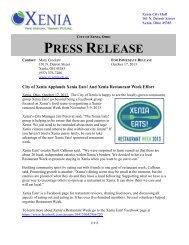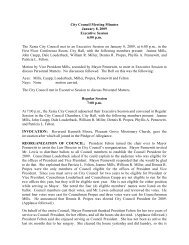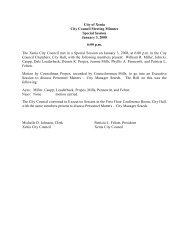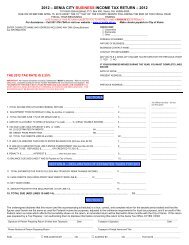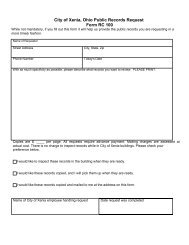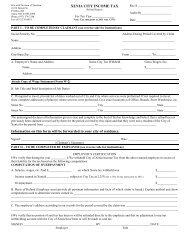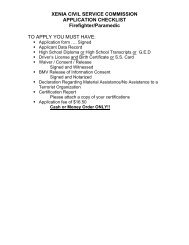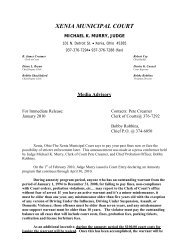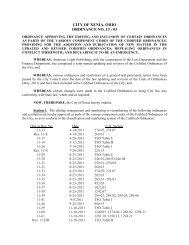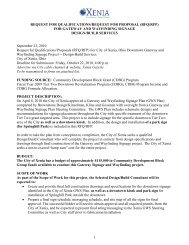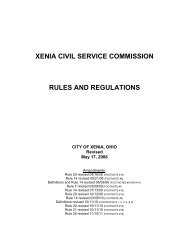Materials Section - City of Xenia
Materials Section - City of Xenia
Materials Section - City of Xenia
You also want an ePaper? Increase the reach of your titles
YUMPU automatically turns print PDFs into web optimized ePapers that Google loves.
2.2 <strong>Materials</strong> - All C-900 PVC pipe shall be made from Class 12454-A or Class 12454-B virgin<br />
compounds as defined in ASTM D-1784, with an established hydrostatic-design-basis rating <strong>of</strong><br />
4,000 PSI for water at 73.4 F.<br />
2.3 Pipe and Gasket - C-900 PVC pipe shall have a cast iron outside diameter and shall be<br />
suitable for use as a pressure conduit. All pipe shall be Pressure Class 150 DR18 unless<br />
otherwise specified on the plans and approved by the <strong>City</strong> Engineer. Provisions must be made<br />
for expansion and contraction at each joint with an elastomeric sealing ring. Laying length shall<br />
be 20-feet ±. The joint shall be in compliance with the requirements <strong>of</strong> ASTM D-3139.<br />
2.4 Marking - C-900 PVC pipe shall be marked as prescribed by AWWA standards; i.e.,<br />
nominal pipe size, dimension ratio (DR), AWWA pressure class, manufacturer’s name and code,<br />
and seal <strong>of</strong> testing agency that certified the suitability <strong>of</strong> the pipe material for potable water<br />
service.<br />
2.5 Approvals - All C-900 PVC pipe used in <strong>Xenia</strong> must be listed by Underwriters Laboratories<br />
and comply with all applicable AWWA requirements.<br />
2.6 Exposure to Sunlight - PVC pipe shall be covered to prevent prolonged exposure to sunlight<br />
(ultraviolet rays).<br />
2.7 Extreme Cold - No installation <strong>of</strong> PVC pipe shall be permitted when air temperature is<br />
below 10 degrees Fahrenheit.<br />
2.8 Receiving, Handling, and Storing Pipe Shipment - All shipments should be inspected as<br />
soon as possible after arrival. After examining the load for any damage that may have occurred<br />
during transit and checking the quantity, size, and class <strong>of</strong> pipe against the packing slip, the<br />
unloading <strong>of</strong> the pipe can begin.<br />
The preferred method <strong>of</strong> unloading is to remove each unit intact by the use <strong>of</strong> mechanical<br />
equipment. The units should be picked up with a forklift truck or by a sling, being careful to<br />
avoid excessive swinging. Since the impact strength <strong>of</strong> PVC pipe decreases in cold weather, care<br />
should be taken neither to drop the pipe nor to set the pipe down on sharp, protruding objects. If<br />
the pipe is to be stacked in racks, support it every 4-feet. Do not throw, whip, or drop the pipe<br />
and do not use chains to unload. The pipe should be stored away from mud and water with every<br />
attempt to keep it clean.<br />
3.0 Ductile Iron Pipe Water Main<br />
3.1 Ductile Iron - Ductile iron pipe shall conform to the American National Standards Institute<br />
Specification for “Ductile Iron Pipe Centrifugally Cast in Metal Molds for Water or Other<br />
Liquids,” ANSI A21.51 (AWWA C151).<br />
3 February 2007



